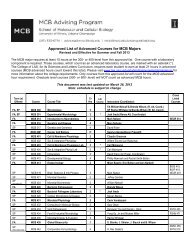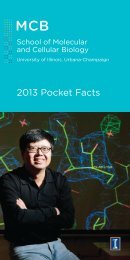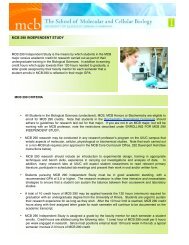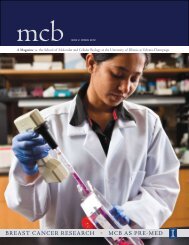collaboration in the life sciences - The School of Molecular and ...
collaboration in the life sciences - The School of Molecular and ...
collaboration in the life sciences - The School of Molecular and ...
You also want an ePaper? Increase the reach of your titles
YUMPU automatically turns print PDFs into web optimized ePapers that Google loves.
Figure: Site-specific phosphorylation <strong>of</strong> histone H1<br />
enhances DNA accessibility <strong>in</strong> chromat<strong>in</strong>. <strong>The</strong> globular<br />
doma<strong>in</strong> (G) <strong>of</strong> histone H1 b<strong>in</strong>ds DNA where it enters <strong>and</strong> exits<br />
nucleosomes <strong>and</strong> stabilizes <strong>the</strong>ir structure. <strong>The</strong> C-term<strong>in</strong>al doma<strong>in</strong><br />
(C) <strong>of</strong> H1 b<strong>in</strong>ds <strong>the</strong> l<strong>in</strong>ker DNA extend<strong>in</strong>g between nucleosomes<br />
<strong>and</strong> promotes chromat<strong>in</strong> condensation—<strong>the</strong> fold<strong>in</strong>g <strong>of</strong> chromat<strong>in</strong><br />
fibers upon <strong>the</strong>mselves to form more densely packed structures.<br />
<strong>The</strong> Mizzen laboratory has discovered that phosphorylation<br />
(+ PO 4<br />
) <strong>of</strong> H1 at specific sites (blue circles) dur<strong>in</strong>g <strong>in</strong>terphase<br />
<strong>of</strong> <strong>the</strong> cell cycle facilitates gene transcription. <strong>The</strong>se <strong>in</strong>terphase<br />
phosphorylations are thought to promote H1 dissociation from<br />
chromat<strong>in</strong>, facilitat<strong>in</strong>g transcription by promot<strong>in</strong>g chromat<strong>in</strong><br />
decondensation <strong>and</strong> enabl<strong>in</strong>g regulatory prote<strong>in</strong>s to b<strong>in</strong>d sites<br />
previously occupied by nonphosphorylated H1.<br />
john GERLT<br />
“We have sequences for more than 10 million prote<strong>in</strong>s <strong>and</strong><br />
we might know <strong>the</strong> specific functions <strong>of</strong> half <strong>of</strong> those,” Gerlt<br />
said. “But what do <strong>the</strong> o<strong>the</strong>r half do If we knew <strong>the</strong>ir functions,<br />
imag<strong>in</strong>e how we might use <strong>the</strong>m to identify new drug<br />
targets or provide catalysts used <strong>in</strong> <strong>in</strong>dustry.”<br />
Gerlt <strong>and</strong> co-researcher Patricia Babbitt, <strong>of</strong> <strong>the</strong> University <strong>of</strong><br />
California, San Francisco, have led <strong>the</strong> way <strong>in</strong> develop<strong>in</strong>g<br />
a novel method to determ<strong>in</strong>e an uncharacterized prote<strong>in</strong>’s<br />
function. <strong>The</strong>ir approach uses computational methods to<br />
narrow <strong>the</strong> range <strong>of</strong> possible substrates for <strong>the</strong> enzyme. Gerlt<br />
says this project is a potentially powerful way to exploit <strong>the</strong><br />
sequence data that have not yet been deciphered; it also<br />
could provide a way to learn more about metabolic pathways<br />
crucial to all organisms.<br />
A team <strong>of</strong> researchers led by Pr<strong>of</strong>essor <strong>of</strong><br />
Biochemistry John A. Gerlt has received a fiveyear,<br />
$33.9 million grant from <strong>the</strong> National<br />
Institutes <strong>of</strong> General Medical Sciences (NIGMS) to<br />
study <strong>the</strong> functions <strong>of</strong> unknown enzymes.<br />
This “glue grant” was awarded to provide resources to tackle<br />
<strong>the</strong> “complex problems that are <strong>of</strong> central importance to<br />
biomedical science but are beyond <strong>the</strong> means <strong>of</strong> any one<br />
research group,” accord<strong>in</strong>g to <strong>the</strong> NIGMS. Gerlt’s team will<br />
develop a strategy for discover<strong>in</strong>g <strong>the</strong> functions <strong>of</strong> unknown,<br />
or uncharacterized, enzymes discovered <strong>in</strong> genome-sequenc<strong>in</strong>g<br />
projects.<br />
“Genome projects have taught us that many <strong>of</strong> nature’s enzymes<br />
have unknown functions that need to be discovered,”<br />
said Gerlt, an expert on <strong>the</strong> enolase superfamily <strong>of</strong> enzymes.<br />
Enzymes are prote<strong>in</strong>s that catalyze <strong>the</strong> chemical reactions<br />
required for <strong>life</strong>, <strong>and</strong> enable organisms to live <strong>in</strong> complex<br />
environments <strong>and</strong> adapt to a variety <strong>of</strong> conditions.<br />
For <strong>the</strong> glue grant, <strong>of</strong>ficially known as <strong>the</strong> Enzyme Function<br />
Initiative, Gerlt <strong>and</strong> Babbitt have assembled a team<br />
<strong>of</strong> researchers from several discipl<strong>in</strong>es to determ<strong>in</strong>e <strong>the</strong><br />
structure <strong>of</strong> an unknown enzyme <strong>and</strong> <strong>the</strong>n, computationally,<br />
determ<strong>in</strong>e a “hit list” <strong>of</strong> possible substrates, number<strong>in</strong>g<br />
<strong>in</strong> <strong>the</strong> tens, ra<strong>the</strong>r than <strong>the</strong> thous<strong>and</strong>s.<br />
<strong>The</strong> team <strong>of</strong> researchers comprises scientists from <strong>the</strong> Albert<br />
E<strong>in</strong>ste<strong>in</strong> College <strong>of</strong> Medic<strong>in</strong>e, Boston University, Texas A&M<br />
University, <strong>the</strong> University <strong>of</strong> New Mexico, <strong>the</strong> University <strong>of</strong><br />
Utah, <strong>the</strong> V<strong>and</strong>erbilt University <strong>School</strong> <strong>of</strong> Medic<strong>in</strong>e, <strong>and</strong> <strong>the</strong><br />
University <strong>of</strong> Virg<strong>in</strong>ia. <strong>The</strong> team also <strong>in</strong>cludes a microbiology<br />
group led by Pr<strong>of</strong>essor <strong>of</strong> Microbiology John Cronan.<br />
“This program ga<strong>the</strong>rs toge<strong>the</strong>r an outst<strong>and</strong><strong>in</strong>g group <strong>of</strong> researchers<br />
who will use <strong>the</strong>ir expertise <strong>in</strong> enzymology, structural<br />
biology, computational model<strong>in</strong>g <strong>and</strong> bio<strong>in</strong>formatics to<br />
develop an approach to associate enzymatic functions with<br />
genes <strong>in</strong> thous<strong>and</strong>s <strong>of</strong> organisms,” said Warren Jones, <strong>the</strong><br />
chief <strong>of</strong> <strong>the</strong> Biochemistry <strong>and</strong> Biorelated Chemistry Branch<br />
<strong>in</strong> <strong>the</strong> Division <strong>of</strong> Pharmacology, Physiology <strong>and</strong> Biological<br />
Chemistry at <strong>the</strong> NIGMS. •<br />
SCHOOL OF MOLECULAR AND CELLULAR BIOLOGY . 11
















